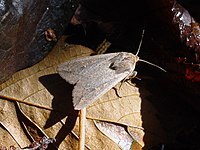
Photo from wikipedia
Mythimna unipuncta is a species with low susceptibility to the Bacillus thuringiensis (Bt) toxin, and this insect occasionally causes devastating damage to maize. In the study region, M. unipuncta-developed larvae… Click to show full abstract
Mythimna unipuncta is a species with low susceptibility to the Bacillus thuringiensis (Bt) toxin, and this insect occasionally causes devastating damage to maize. In the study region, M. unipuncta-developed larvae were observed moving from a non-Bt crop to a nearby Bt crop. Although the first response of many caterpillars to xenobiotics, such as the Bt toxin, is to reduce food intake and prolong development, few studies have focused on the causes and consequences of this response in terms of resistance evolution. To clarify the causes of this response, this work compared changes in the feeding behaviour, cytochrome P450 expression and juvenile hormone titre during the last larval instar of M. unipuncta after Bt ingestion. Four P450 enzymes related to the xenobiotic metabolism of the CYP9 and CYP6 families were identified. Developed larvae fed the Bt diet reduced their food intake and CYP9 expression, experienced prolonged development and presented an altered juvenile hormone balance. The CYP9s were not increased in the larvae that consumed Bt, as previously expected, although their highest expression was observed when larval feeding increased. The high recovery capacity of the larvae contributed to their development when they were fed a non-Bt diet. The efficiency of responses that act jointly as a defence mechanism against Bt might favour the development of field resistance to the toxin. Therefore, these responses should be further investigated for resistance management programmes.
Journal Title: Annals of Applied Biology
Year Published: 2017
Link to full text (if available)
Share on Social Media: Sign Up to like & get
recommendations!